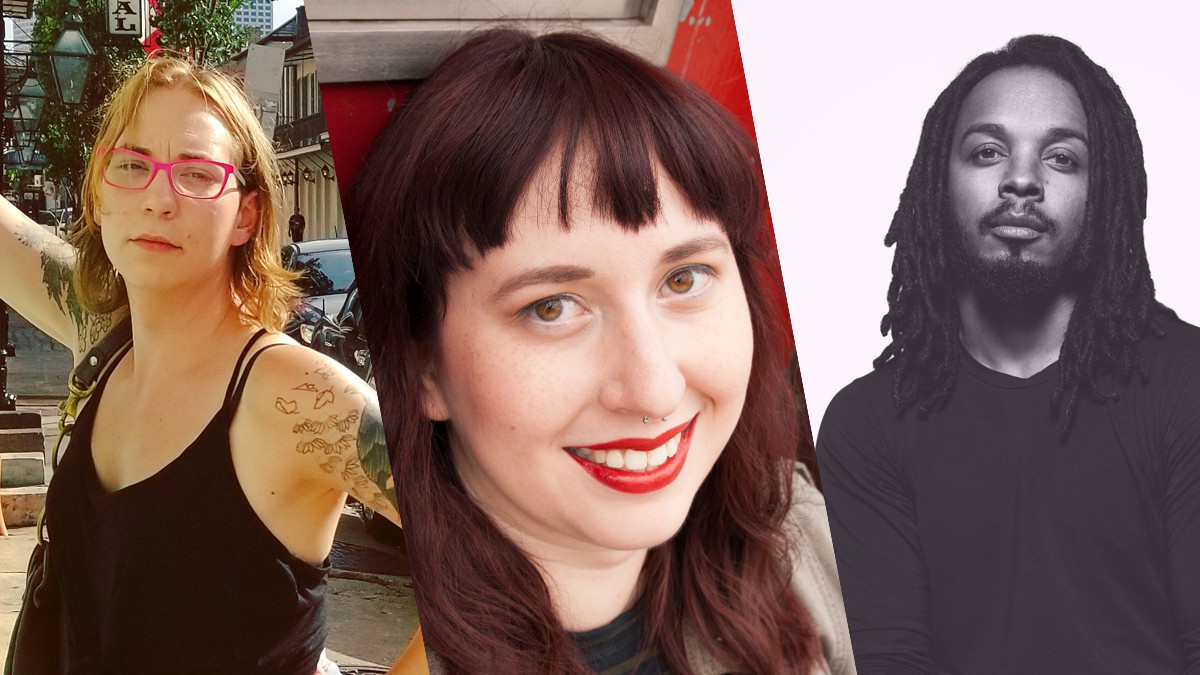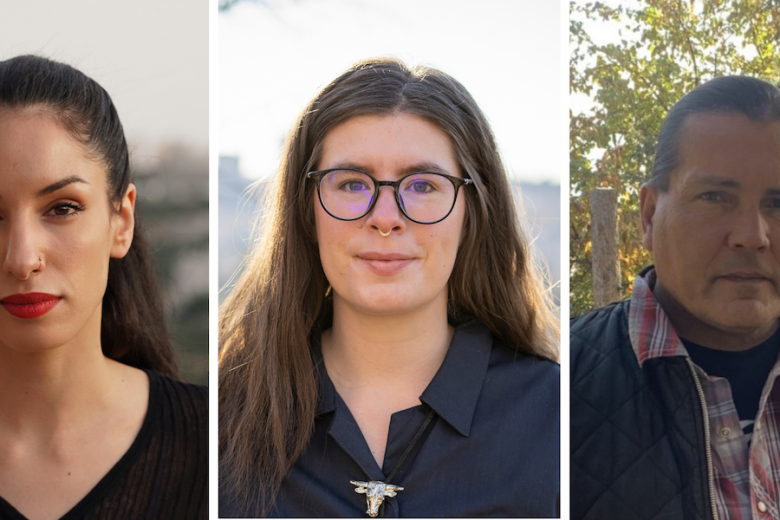This year marks the eighth edition of Briarpatch’s Writing in the Margins contest, where we invite our readers to bring to life issues of social, political, and environmental justice. Winners are published in Briarpatch, and have the chance to win $1,950 in prizes. This year, for the first time, we’re expanding the contest beyond poetry and creative non-fiction to introduce a documentary photography category, which will be judged by Jalani Morgan.
Gwen Benaway, the judge of the poetry category, is a trans girl of Anishinaabe and Métis descent. She has published two collections of poetry, Ceremonies for the Dead and Passage, and her third collection, Holy Wild, was published by Book*hug in September. She lives in Toronto and is a PhD student at the Women and Gender Studies Institute at the University of Toronto.
Alicia Elliott will judge our creative non-fiction entries. Alicia is a Tuscarora writer from Six Nations of the Grand River living in Brantford, Ontario. She won a National Magazine Award in 2017, and was chosen by Tanya Talaga to receive the RBC Taylor Emerging Writer Award in 2018. A Mind Spread Out On the Ground, her debut book of essays, is forthcoming from Doubleday Canada in March 2019.
Jalani Morgan is an established Toronto-based photographer, visual historian, and photo editor who is known for his editorial, documentary, and gallery-collected work. His creative work explores visual representation within a Black Canadian context and focuses on documenting and portraying images of Black life both in Canada and internationally.
Briarpatch editor Saima Desai talked to Gwen, Alicia, and Jalani about their politics, writing, and photography.
What do you think is the role of writing in social movements?
Gwen: I think writing arises from living. Life is shaped and understood through collective and communal experiences. Social movements, a terminology which I think unfairly displaces the living of marginalized and oppressed peoples into the socio-cultural, are often acts of embodied resistance to violence. For me, my living and writing arises within a context of resistance to the forces which seek to destroy my living.

I think my work tries to articulate my living as more simply survivance. I see my work and living as resistance and something beyond resistance, a kind of affective possibility. A distressed hopefulness in the capacity of oppressed peoples to endure but also innovate. To create other worlds inside of this one which sing with the fullness of our capacity, the unimagined and refused possibility of our bodies and intimacy as something more than a social movement. A womb, a literary living that comprises a birthing of new futures through the death of the dominant narratives, which allows for freedom.
I guess I can’t tell the difference between living and writing, the social and the political, the body and the voice, the binary and the limitlessness of my heart. I’m trans, and by that I mean I’m beyond what the world can contain.
Alicia, what is the role of beauty in your work?

Alicia: The Haudenosaunee Thanksgiving address is a way of thanking and acknowledging every part of Creation that allows us to live. In practice, that means thanking and acknowledging the waters, the trees, the medicines, the animals and birds, Elder Brother Sun, Grandmother Moon, the Thunderers, and so on. That’s beautiful to me – that we as a people would take the time to acknowledge that in the mornings, in the evenings and before and after every meeting. I don’t know any Haudenosaunee languages right now, but each morning and evening, as I’m taking my dog for a walk, I stop to admire the beauty of creation, and thank each part of it in English. Actually saying it aloud every day has helped me really solidify why I write. I hope my appreciation of and love for the world permeates my work – that it’s underpinning every word and sentence, even if that love isn’t specifically articulated. The beauty and wonder of this world is what I always try to come back to, even when I’m writing about something difficult or traumatic or troubling. That’s what keeps me going, and that’s what I want to leave readers with: the memory that there is something beautiful here, that there is something still worth fighting for, even when it all seems so ugly.
Gwen, you recently wrote an article for GUTS Magazine about the expectation that women must heal from sexual violence. You say, “Requiring victims to not only survive but heal allows society to excuse its complicity in the intimate violence committed by men.” What role does your writing play in healing, or resisting the demand to heal?
Gwen: Writing about healing from sexual violence and trauma has been a lifelong work for me. I’ve been writing about abuse, intimate violence, and intergenerational trauma since my first collection of poetry. I’ve always been skeptical of “healing” in the context of abuse because my first experiences of the institutional language of “healing” [were] from social workers and hospital staff. I was a child trying to leave the violence of my family home and I was met with folks from Children’s Aid, clinical psychiatry, and youth home workers who weaponized the language of “healing” in a particular way.
I remember one of the social workers saying to me that I was “very angry” and needed to “heal.” The circumstances of my anger were reasonable and necessary, but the implication that my “healing” was my salvation really upset me. It absolved others in my life – the institutions, my parents, the state, the intergenerational colonial forces which created my childhood – from their role in what I was experiencing and placed the burden of survival on me via my capacity to “heal.”
In my writing, I’ve always pushed back on the idea that healing is an appropriate answer to violence. I think many survivors are told to heal and [are] shamed for not healing quickly or in the “right” ways, but healing isn’t something that just arises from within. Healing requires facilitation from the outside and most importantly, it requires the external forces which are creating the violence in the first place to stop harming you. In the absence of that occurring, healing itself can be a continuation of the original violence.
My goal with my writing has been to try and make space [for] the mess of surviving and the impossibility of healing without abandoning the hope for transformation or the miracle of “justice.”
Jalani, in March, one of your photos of a Black Lives Matter – Toronto march for justice for Andrew Loku was displayed in a crossover episode between two of Shonda Rhimes’ hit drama-thriller shows, Scandal and How to Get Away with Murder. Do you see the visibility of the BLM movement as always positive, or can it be negative – especially considering the virality and hypervisibility of images of Black death and pain in mainstream media?

Jalani: I feel it’s problematic to draw a link between Black death and pain, and Black Lives Matter. In fact, it’s a contradiction, by virtue of the name Black Lives Matter. I will not link the hypervisibility of Black death and pain to that of Black Lives Matter, period. Hypervisibility of Black death and pain has existed as long as colonizers began this period of global imperialism and colonization. Some solid research – or even quick research – of art history will see the artists of the past reflect in their art the destruction of Black folks on a micro or macro level. Pull from any era of modern history and look at the art that exists, and you’ll see Black death and pain.
This is the first year that we’ve decided to introduce a photography category in the Writing in the Margins contest. Jalani, what are the pitfalls of most traditional photography contests, and how are you hoping to work around them in this contest?
Jalani: Representation of judges and fees would be a couple of the problems I’ve seen in contests. I still, up until this year, have seen photography contests that tokenize their judges, and often the costs of competitions can be a barrier for some folks. You and I have spoken about those barriers in regards to this competition, and it’s my hope that the work that I’ve put in has given me the clarity to judge this contest with an earnest and equitable eye.
What advice do you have for writers, poets, or photographers who are considering entering this contest?
Gwen: Speak truth to power in the language of your everyday life. Speak as only you can speak without worrying about appearing clever or meeting some technical judgment of what “good writing” is. Speak to and through your body toward your liberation. It may not be everyone’s liberation, but as long as you write towards freedom, you will do the work that needs to be done.
Alicia: Really ask yourself why you’re writing what you’re writing; why you want to write it, why you need to write it, and why you’re the person who should write it. In answering those questions, you’ll find out so much more about what your piece can be, and what it can’t, and you’ll imbue your writing with an honesty and freshness that will take you exactly where you need to go.
Jalani: Whom do photos serve? Ask that question before you take a photo, as you write your ideas down, and certainly when looking at the body of work. This isn’t just photography for the sake of image making – this work represents a voice. Whose voice is at the centre of it? A photographer should be able to index the moment while not silencing the voices of the folks in the photo.
There are bursaries available that will cover the $25 entry fee for 10 low-income entrants.
The deadline for submissions to the Writing in the Margins contest is December 1, 2018. Find contest details here.
This interview has been edited for length and clarity.







